Bahrain’s World Trade Centre is one of the first buildings to be designed with wind turbines as part of its structure. It sounds simple, but as Thomas Lane discovered, the problems were many and the answers elusive
Constructing the world’s first building to sport large integrated wind turbines in the most oil-rich region on the planet seems crazy. Just knowing there is so much oil under your feet makes profligate behaviour seem natural: people drive their gas guzzlers on journeys of a few yards and everywhere you go, super strong air-conditioning is engaged in an endless battle with 50°C temperatures. But the fabulous oil wealth of the Middle East also means clients have the money to try something different. So, when you put together a sailor inspired by the power of the wind at sea, and a wealthy client with the money to realise crazy dreams, the idea starts to look more plausible.
The initial concept
This is how it happened. The client, who wants to remain anonymous, invited architect Shaun Killa, sailing enthusiast and design director of Atkins Middle East, to a piece of land near the Gulf coast in Manama in Bahrain to discuss its redevelopment. “When I went, a tremendous wind was blowing – it was at least 25 knots,” says Killa. “It was very clean and uninterrupted, coming off the sea. It was clear to us that the opportunity was there to create a building that would harness that wind.”
The obvious option in such a sun-blessed country would have been solar power, but Killa explains that his choice of wind was based on sound logic as well as instinctive enthusiasm. “Four years ago photovoltaics were very overpriced – about five times as expensive per kilo watt than wind,” he says. “There were also issues about PV panels losing their efficiency when they got hot. I didn’t think they were ready for the Middle East, so it had to be wind.”
A tremendous wind was blowing, clean and uninterrupted. It was clear to us the opportunity was there
Shaun Killa, Atkins Middle East
Fortunately, he says, the brief for the Bahrain World Trade Centre was very fluid: to create a new, upmarket shopping mall linked to an existing one, plus add “50,000m2 of useable space in an office building.”
“The client didn’t specify how many buildings,” says Killa. But even in the Middle East clients are careful not to chuck money away on mad schemes. Killa and his team had to prove the idea was going to work, which was a tough job when it had never been done before.
This required a huge amount of research. The team opted for as many standard components with proven performance records as possible, to keep the client happy and the project manageable. These components included the control systems, the mounting bridges for the turbines and, crucially, the actual wind turbines, which were a type used on early wind farms. “They needed to be rated and certified,” says Killa. “If we chose anything that wasn’t, there would be five years of research and development, and I don’t believe any client would sponsor that.” This meant the building had to be designed around turbines that were intended for a different environment to an office building. “We had to take a wind turbine that was built for a field and create a near perfect environment for it,” explains Killa.
How would it work?
If we chose any component that wasn’t rated and certified, there would be five years of research and development
Shaun Killa, Atkins Middle East
Research showed that about 70% of the wind coming off the Gulf hit the coast head on or within a 60° range on either side. This confirmed that the planned development would work well on the site, but only if the building were designed to straighten out any winds coming in at a slight angle, in order to hit the turbine blades head on for maximum efficiency.
The solution was to create two separate wings with the wind turbines sitting on bridges between them. These two elements are shaped like aerofoils, angled so the distance between the wings is 120m at the front but just 30m at the rear. This creates a funnelling effect that, aided by the shape of the wings, straightens and channels the wind. The outer edges of the wings are also aerofoil-shaped, which creates an area of low pressure just behind the wind turbines. Killa says the design not only directs the wind, but also increases the wind speed so that up to twice as much energy can be extracted from it by the turbines.
Every part of the development has been designed to maximise the effectiveness and efficiency of the turbines. The building has been carefully shaped so each of the three turbines rotates at the same speed. This means that each is generating the same amount of electricity, simplifying control and power conversion systems and ensuring maintenance schedules are the same. Because the wind speed increases towards the top of the building, it tapers to lessen the funnelling effect, keeping the wind consistent over the building height.
Safety first
The client didn’t approve the bridges until we were up to the 9th floor, which was the latest date the decision could be made
Simha Lytherao, Atkins Middle East
Deciding the building shape was only the beginning. There were a huge number of questions that had to be answered. Would the turbines create airborne andstructure-borne noise? Could they deflect and hit the bridges? What would happen if the blades were struck by birds or lightning? Would the flickering caused by the turbine blades cause someone in an adjacent building to have an epileptic fit? The list goes on, covering about 200 possible scenarios. “The threshold we always set was safety and user comfort,” says Simha LytheRao, Atkins’ project manager.
Each scenario was carefully risk-assessed to determine how much risk was acceptable. The team also looked at each part of the building and listed what events could affect it. If the risk seemed too great, measures were put in place to reduce it. For example, there was a high risk that vibrations from the turbine gearbox would be transmitted into the building structure by way of the bridges and would be audible to the occupants in the same way as someone drilling into a wall several floors away. The solution was to mount the turbines on rubber and isolate the bridges from each wing using rubber dampers, which also accommodate the differential movement between the two wings. In addition, lasers are used to monitor the turbine blades; if these get too close to the bridges, the control system shuts the turbines down.
Another big challenge was coming up with the control system itself. There are existing systems for turbines, and for buildings, but nothing that links the two together. Uniting the two was important, as the control system needed to tie the turbines’ output with the electrical demand of the building. Safety issues also came into play, as the turbines need to shut down if there is a fire, or if someone opens one of the doors from the building onto a turbine bridge. “Nobody thinks about the integration of the controls but it was the most difficult part,” says LytheRao. Turbine supplier Norven worked with Atkins to develop a system that would cope with all these requirement by working with the building management system.
Testing the wind
Leaders in the Middle East see this as the future. Its success has contributed to a lot of the green initiatives
Shaun Killa, Atkins Middle East
The crunch moment came in April, when the turbines were switched on briefly to see if all these issues were successfully resolved. “We ran the turbines for 14 hours. There was no vibration or noise at all and nothing which was a concern,” says LytheRao. Killa adds that the turbines produced more power than predicted, spectacularly vindicating his vision and the team’s hard work (see box: How much power does it produce).
The building is scheduled for completion at the end of the year and is apparently fully let. Was all the work worth it? Killa thinks so. He has also been surprised by the positive response the building has received from locals, and from other parts of the Middle East. “We were told unofficially that a lot of the leaders in the Middle East started to see this as the future,” he says. “There needs to be a new consciousness. This building’s success has contributed to a lot of the green initiatives in the region.”
The new wave of eco-enthusiasm he refers to includes zero-carbon city Madur in Abu Dhabi and the new green regulations in Dubai, plus a rash of new, low energy buildings such as the Dubai International Financial Centre Lighthouse (see box: What’s next). Making the Middle East’s inhabitants think more carefully about the oil beneath their feet is no mean achievement.
How much power does it produce?
Each of the three turbines produces 225kW when running at full capacity, totalling 675kW. This is estimated to produce a total of 1,300MWhr a year.
Calculations show that the wind turbines should produce 10% to 15% of the building’s energy needs, and this includes all the occupants’ power use, too. But this figure is negated somewhat as the building is cooled via a district cooling system.
Killa says that the calculations were very conservative.
When the turbines were tested in April they produced more power than anticipated, and the calculations were based on a much higher occupant density than the actual finished design.
Efforts have been made to reduce the energy the building uses. Sources from Atkins say there is some potential for natural ventilation in the winter as the balconies have opening doors, and the concrete structure means the building has high levels of thermal mass.
The building is narrow-plan which means it receives high levels of natural light and LytheRao points out that district cooling is less energy intensive than a building-based system. He does concede, however, that it is not a low energy building.
Unfortunately, the local power company has not yet caught up with the idea of a renewable energy network, and refuses to allow any power to be fed into its grid. Atkins had to convince the power company that power from the turbines would not migrate into the grid. This means that the power-generating potential of the turbines goes unused during evenings and weekends.
“It means we cannot generate power unless the building’s electrical demand is more than the turbines can produce,” says LytheRao.
The team are considering ways of making the most out of the output of the turbines during dead periods by installing a chiller to make ice, which could be used to cool the building during the day and reduce reliance on the district cooling system.
In the long term, the team hopes that the power company might change its mind about accepting power from the wind turbines. Here, the signs are good; the power companies in Dubai and Abu Dhabi recently started accepting feed-in power, as the rulers recognised that this is the
only way renewable energy can be efficiently generated.
Was it difficult to build?
Despite the unusual nature of the building the client still wanted it delivered in double-quick time. This is not unusual in today’s Middle East.
In 2004, the design was at the concept stage, and normally another 12 to 18 months would be needed to complete the research and work up the detailed version. But construction started in June 2004, so the team had to complete their research and detailed design as the building was being constructed.
This meant some close calls, for example, the team had not finalised the design of the bridges to support the turbines until the building was well out of the ground. “The client didn’t approve the bridges until we were up to the 9th floor, which was the latest date the decision could be made,” says LytheRao. He adds that the building was designed to function with or without the turbines, in case there was no time to incorporate them into the finished building.
The building structure was only marginally beefed up to cope with the additional weight of the bridges and turbines, but at 70 tonnes the bridges were too heavy to lift into position by crane so this had to be done by strand-jack. Then the turbines’ nacelles were installed and, finally, the blades were assembled on the ground and craned up as a unit, a tricky job because of the wind.
How long will it last?
How well the turbines will work in 10 or 20 years is open to question. At the moment, the Bahrain World Trade Centre stands with no tall buildings around it, which means it enjoys clean, uninterrupted wind. This is bound to change, as the building occupies a very desirable spot and future development may well affect wind quality. “At the moment there is nothing in front of the building, and what is currently planned won’t affect it,” says LytheRao. “In the medium term nothing will change, but this is the Middle East and anything can happen.”
Although it would be unfortunate if new development compromised the impact and efficiency of the turbines, the key achievement – the principle of integrating large-scale wind turbines into a building – will remain. The financial loss would also not be too significant, as the turbines and support bridges added just 3-4% extra to the building budget.
Killa says early calculations showed the payback period was 17–20 years but the 10% additional rental premium the building commands reduces that to just 2.5 years, even without allowing for recent energy price hikes.
What’s next?
The experience Atkins has gained from the Bahrain World Trade Centre is already feeding into other projects. It has designed the Dubai International Finance Centre’s Lighthouse Tower, which has three big integrated wind turbines at the top of the building.
Although Dubai has wind speeds about 30% lower than in Manama, at 402m the building is much taller, which offsets this. It also has 4,000 photovoltaic panels. These renewable technologies will contribute 12% of the building’s energy needs, for much higher occupant densities than the Bahrain building. It also incorporates other energy-saving features such as chilled ceilings rather than
power-hungry fan-coil units, regenerative double-deck lifts and low energy lighting systems.
The combination of the renewable energy technologies and energy-saving design cuts total energy use by 50-55% compared with a standard good-practice building.
Killa also designed another building for Dubai with integrated wind turbines, which would have included six 7,500kW turbines producing a whopping 4.5MW of power. The project was cancelled, but given the rate of development in the region it will not be long before something similar gets built.
Project team
client representative and cost manager HAJ
principal consultant, architect, project manager and structural design, mechanical and electrical engineer Atkins Middle East
main contractor Nass and Murray & Roberts joint venture
bridge subcontractor Ramboll




















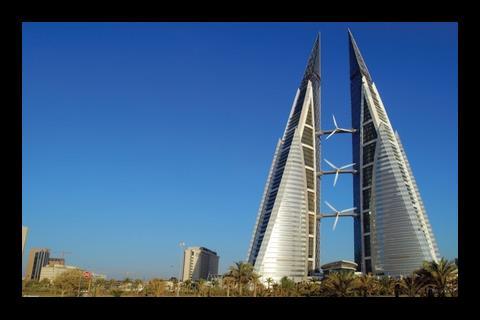
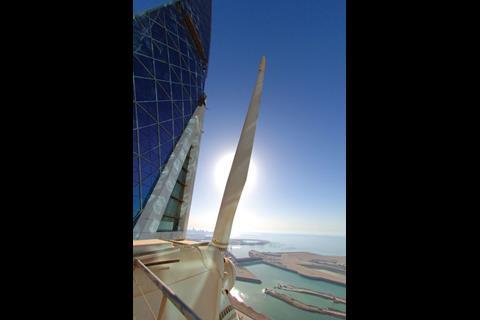
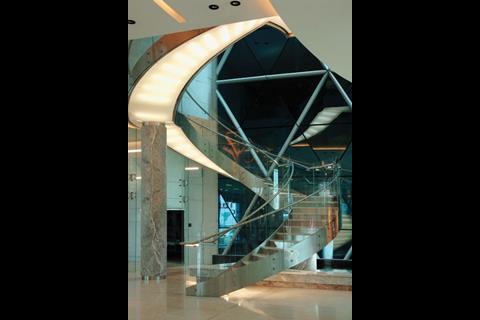


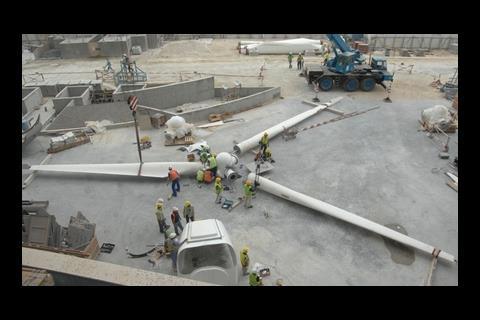
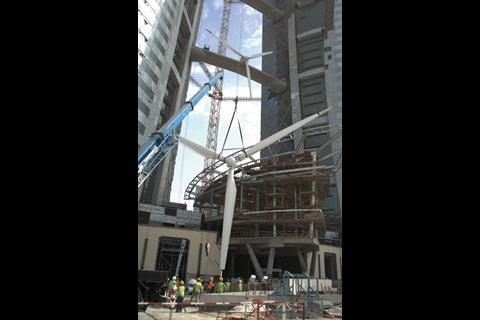


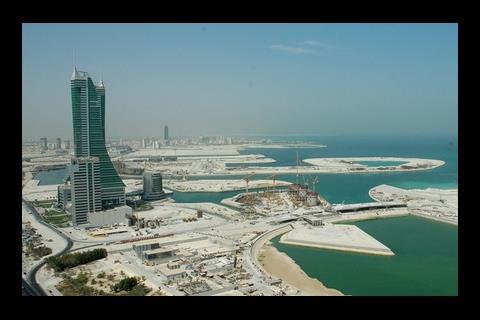
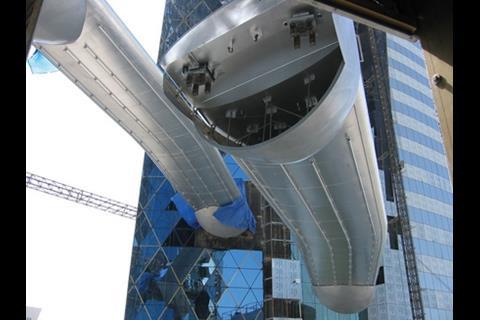
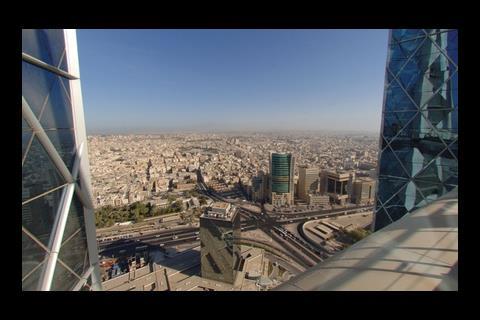








No comments yet